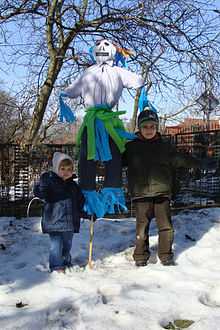Marzanna


Marzanna (in Polish) or Morena (in Czech, Slovak, Russian) or also Mara, Maržena, Morana, Moréna, Mora or Marmora is a Slavic goddess associated with seasonal agrarian rites based on the idea of death and rebirth of nature. She is associated with death and winter and is often described as the goddess of death. As the Goddess of death and winter she appears in different guises. Her proficiency in different guises is a reoccurring trait that sticks out in the stories told about her. To this day in some regions of Poland, there is a festival held where an effigy of Marzanna is made in the month of March, and is burned to symbolize the triumph of springtime over winter. This is known as The Burning and Drowning Ritual of Marzanna.
Some medieval Christian sources such as the Czech 9th century Mater Verborum also compare her to the Greek goddess Hecate, associating her with sorcery. 15th century Polish chronicler Jan Długosz likened her to Ceres, the Roman goddess of agriculture.
Etymology
Vyacheslav Vsevolodovich Ivanov and Vladimir Toporov supposed her name was derived from the same root as the name of Roman god of war Mars, originally an agricultural deity.[1] Other theories claim her name is derived from the same Indo-European root as Latin mors 'death' and Russian mor 'pestilence'. Some authors also likened her to mare, an evil spirit in Germanic and Slavic folklore, associated with nightmares and sleep paralysis. In some Russian dialects the word 'mara' means 'phantom', 'vision', 'hallucination'.[2]
Traditions

The tradition of burning or drowning an effigy of Marzanna to celebrate the end of winter is a folk custom that survives in the Czech Republic, Poland and Slovakia. For many years, the Burning and Drowning of Marzanna was held on the fourth Sunday of Lent and it was not until the 20th century that the date 21 March was fixed, which coincidentally is the day of the vernal equinox [3] (20–21 March). The rite involves preparing a doll dressed in female clothing, which can then be set on fire, drowned in the river, or both. The Church tried to Christianize the tradition of Marzanna and replace it by burning Judah or throwing Judah puppet from the churches' roof on Holy Wednesday. This tradition is cultivated in some Polish regions, but Marzanna tradition is known much better all through Poland.[4]
In the Czech Republic or Poland, this is often performed during a field trip by children in kindergartens and primary schools.[5] The effigy, often prepared by the children themselves, can range in size from a puppet to a life-size dummy. This ritual represents the end of the dark days of winter, the victory over death, and the welcoming of the spring rebirth.
It concerns the "drowning of Marzanna," a large figure of a woman made from various rags and bits of clothing which is thrown into a river on the first day of the spring calendar. Along the way, she is dipped into every puddle and pond ... Very often she is burned along with herbs before being drowned and a twin custom is to decorate a pine tree with flowers and colored baubles to be carried through the village by the girls. There are of course many superstitions associated with the ceremony: you can't touch Marzanna once she's in the water, you can't look back at her, and if you fall on your way home you're in big trouble. One, or a combination of any of these can bring the usual dose of sickness and plague.—Tom Galvin, "Drowning Your Sorrows in Spring", Warsaw Voice 13.544, March 28, 1999
See also
| Wikimedia Commons has media related to Morana. |
References
- ↑ Vyacheslav Vsevolodovich Ivanov, Vladimir Toporov. Indo-European Mythology. / В. В. Иванов, В. Н. Топоров. Индоевропейская мифология. Мифы народов мира, М:Российская энциклопедия, 1994.
- ↑ Мара (Mara) in Explanatory Dictionary of the Living Great Russian Language by Vladimir Dahl.
- ↑ "Polska". Retrieved 12-1-2113.
- ↑ "Sinking of Marzanna - Pagan Traditions of Spring". Retrieved 2013-11-28.
- ↑ http://www.folklornisdruzeni.cz/vynaseni-morany-v-dolni-lomne
Sources
- Dixon-Kennedy, Mike. Encyclopedia of Russian & Slavic myth and legend. ABC-CLIO Publisher, 1998
- Marjorie Yovino-Young. Pagan Ritual and Myth in Russian Magic Tales: A Study of Patterns. Edwin Mellen Press, 1993.
- Skvortzov, Konstantin. Mater Verborum, 13th century Czech manuscript, with comments. Saint Petersburg Academy of Sciences, 1853.
- http://www.bellaonline.com/articles/art171090.asp
| ||||||||||||||||||||